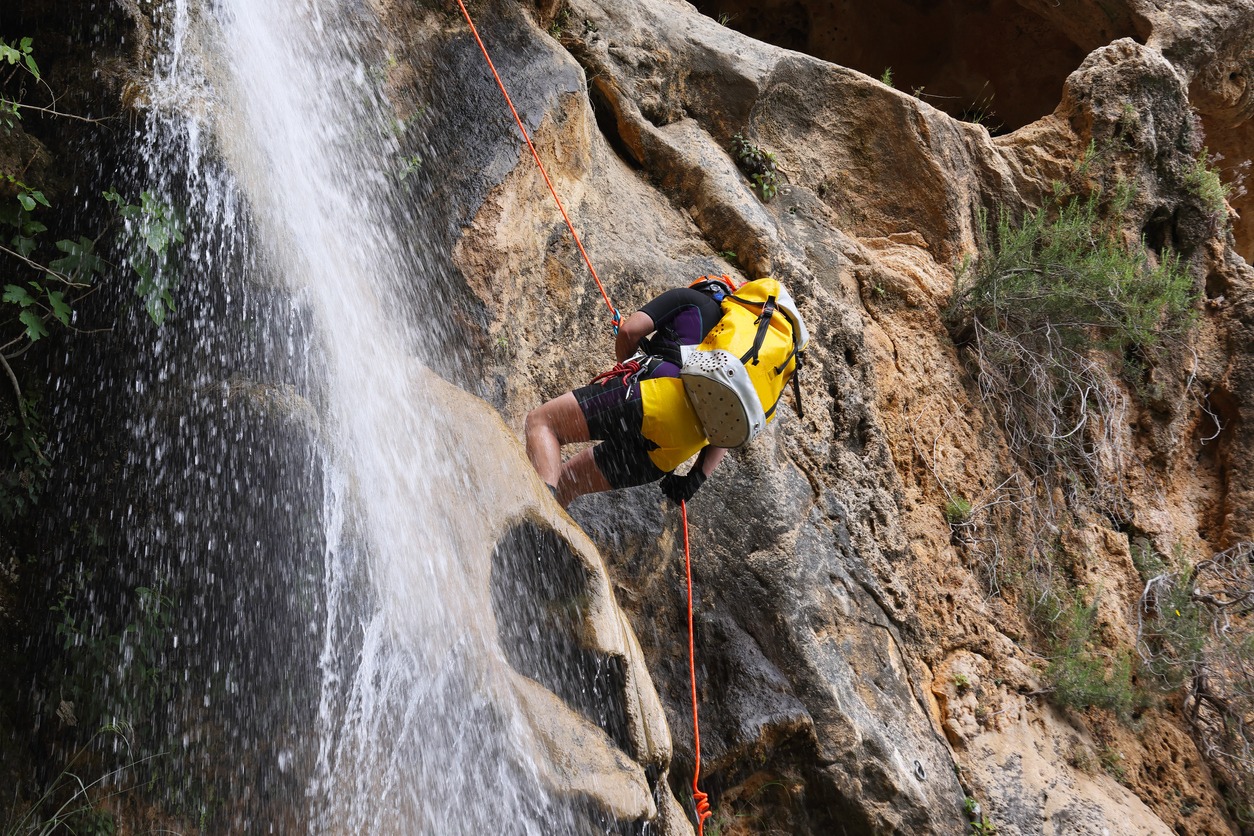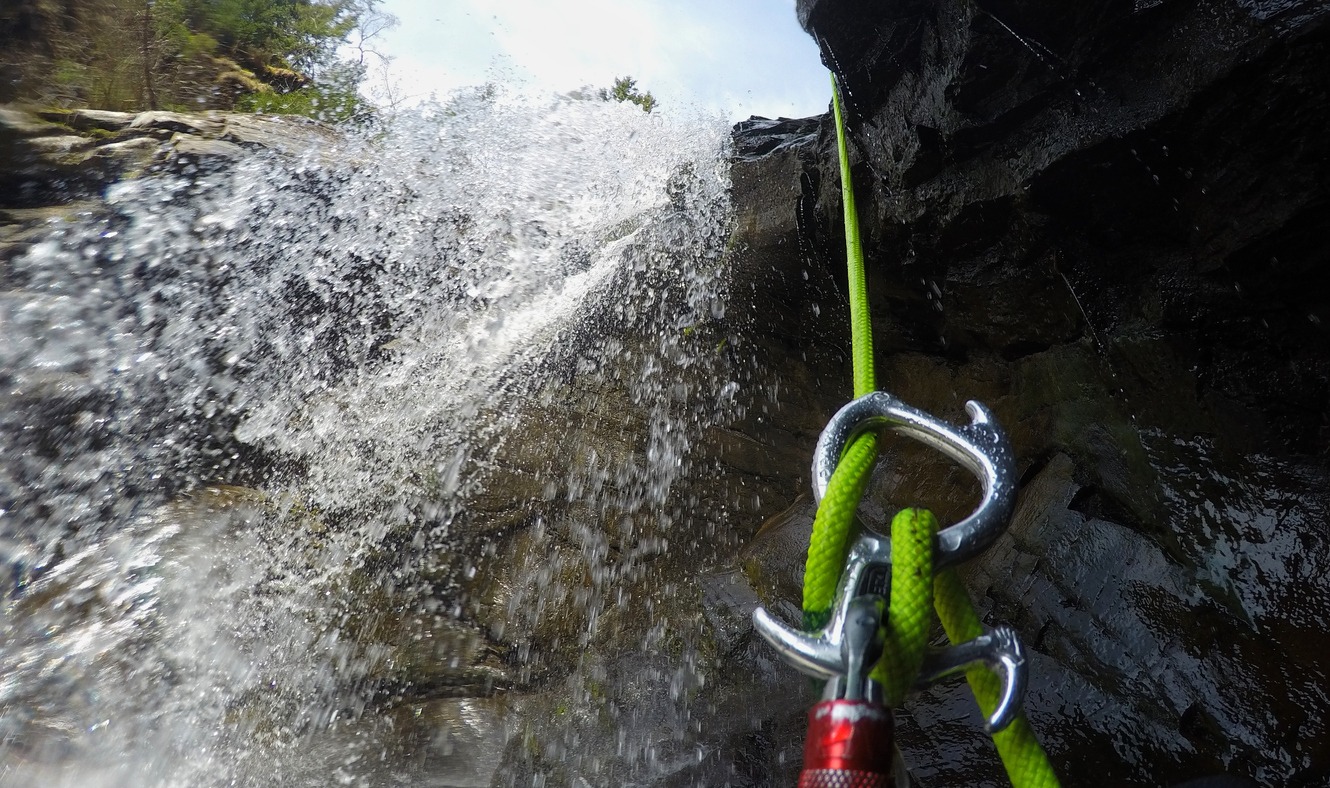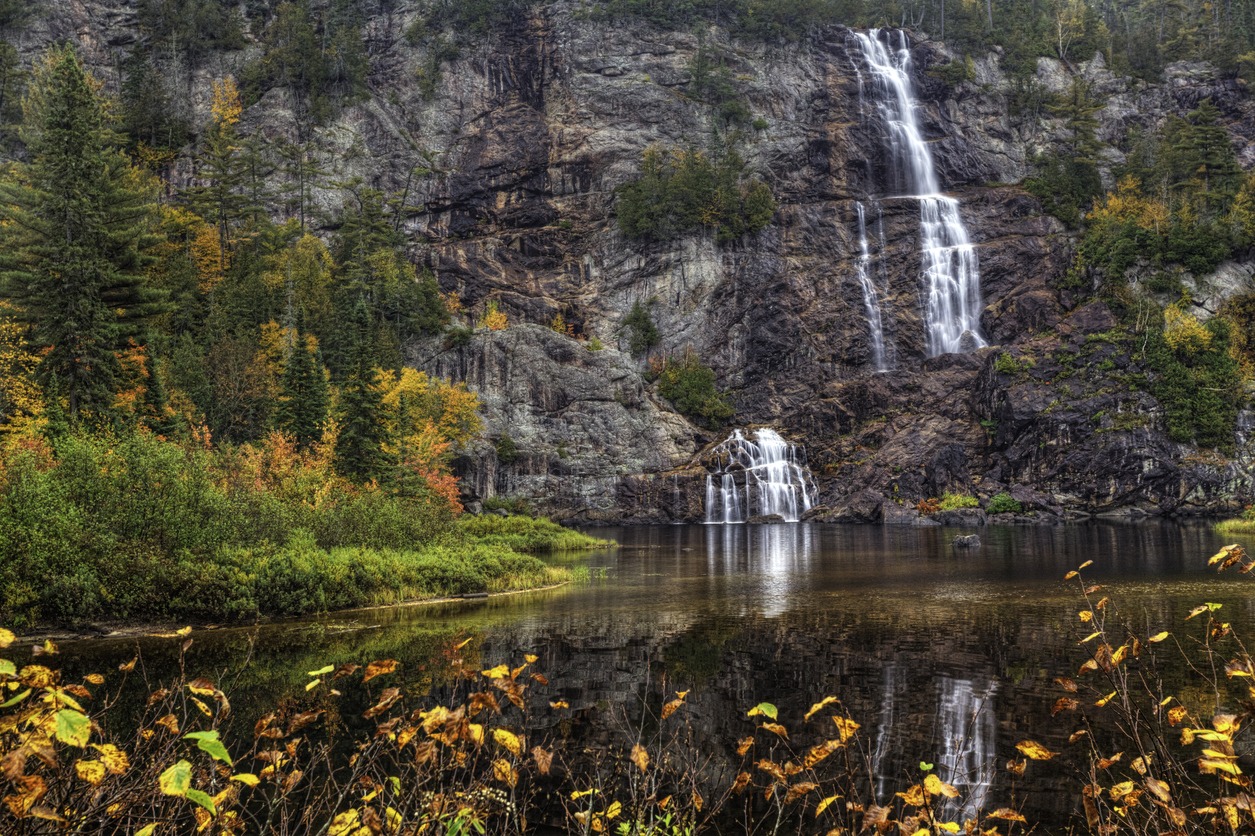Canyoning (called “canyoneering” in the U.S. and “kloofing” in South Africa) is a type of mountaineering in which people travel through canyons using different methods, such as walking, scrambling, climbing, jumping, abseiling (rappelling), and swimming. It’s a sport that goes by a lot of different names. People do it to explore hard-to-reach parts of nature by following a water route carved through rock formations.
Canyoneers slide, jump, and climb down through the gorge, often using technical gear for safety. They follow paths along streams, pools, and waterfalls. It can be done mostly for fun and to get more experience, but also because the course is hard and the terrain is tough.
How hard a canyon is depends on how much water is in it and how many vertical obstacles there are.
Abseiling, also called “rappelling,” is an advanced form of canyoning that involves descending into more difficult areas with the help of technical equipment.
Canyoneering is sometimes used to describe non-technical descents like canyon hiking. However, the terms canyoning and canyoneering are more often used to describe technical descents that involve abseils (rappels) and ropework, technical climbing or down-climbing, technical jumps, and/or technical swims.
Canyoning is often done in rough and remote places, and you often need to know how to navigate, find your way, and use other skills for traveling in the wilderness.
Canyons that are good for canyoning are often cut into the bedrock stone, making narrow gorges with many drops, beautifully sculpted walls, and sometimes spectacular waterfalls. Most canyons are carved out of limestone, sandstone, granite, or basalt, but they can also be made out of other types of rock.
Equipment Needed
Equipment for canyoning varies depending on the program, but the following items are common:
Canyoning shoes: The watery nature of a canyon necessitates a pair of sturdy, water-resistant footwear.
Wetsuit: In cold and deep canyons, a wetsuit’s durability and warmth are essential, as is its ability to keep you dry. Having a quick-drying shirt and shorts on hand will ensure you’re ready for any wild and woolly experience.
Helmet: Protecting one’s head should go without saying. A helmet will protect your head in the event of a fall down the canyon’s slippery slopes.
Gloves: Wearing gloves can help keep your hands safe while exploring the rocks, but they aren’t always necessary. They can also help you keep your footing as you make your way down the canyon.
Static rope(s): It is best to use static ropes for abseiling, as they are more stable under pressure. Canyoning is impossible without the use of these ropes.
Dynamic ropes, on the other hand, are used to secure falls and improve safety on ascents in climbing and are associated with it.
Rope Bag: Carry ropes in a durable and convenient rope bag to keep your hands focused on the task at hand. This makes it easier for the canyoneer to deal with them.
Water-proof bag: Your belongings and equipment will remain dry if you use a water-resistant bag or pack. To keep the descent from stuttering, it should be self-draining and lightweight to minimize drag.
Descender: As a descender, a belay system is essential. Sliding along the canyon floor, the descender manages and controls the descent, making it safe for belay to give and take rope.
Harness: In order to abseil and, if necessary, climb the canyon walls, canyoneers wear harnesses attached to a rope.
Carabiner: A carabiner connects the harness and the descender and is useful for securing and carrying items in the canyon. Slings and other gear can be attached with the help of a few of these simple-to-lock devices.
Sling: A sling is a useful safety precaution in exposed areas because it holds the climber’s anchors securely.
Other possible items include a knife, a communication device, sun protection, swimwear, and a camera.
Several of these items can be rented on-site or prior to a canyoning trip, and the canyoning guide may provide them. Participants may be required to bring their own equipment in some cases. Depending on the terrain and weather, a particular canyon or route may necessitate the use of additional equipment.
Worldwide Canyoning
Canyons are everywhere, so adventurers will travel far to explore them. These are the world’s most epic canyoneering destinations.
Arizona’s Antelope Canyon
This slot canyon near Page, Arizona is on Navajo land. Popular with tourists, photographers, and canyon enthusiasts, access is restricted to guided tours. Upper Canyon is walkable. Lower Canyon is longer, deeper, and requires ladders and strategic navigation. This is easier than Zion’s canyons and doesn’t require technical rappelling or swimming.
Australia’s Blue Mountains
Canyoneering enthusiasts love Australia’s Blue Mountains. Explore 400 canyons here! GC Empress Falls is a bucket-list canyon for experienced hikers. Here you can rock climb, rappel, raft, and spelunk. Both beginners and experts can find an appropriate canyon. Amazing waterfalls await, so dress to get wet.
Agawa, Canada
Agawa Canyon is known for its scenic train tours, but it’s also great for canyoning. This wilderness area is only accessible on foot, so expect untouched forests. The changing leaves in autumn make this canyon’s hardwood forests glow with color. In winter, you can ice climb in the canyon. Experienced climbers should avoid the 575-foot granite canyon walls here.
Nepal’s Jalbire Canyon
Jalbire Canyon is one of Nepal’s best canyoneering spots. This canyon is on the Trisuli River between Panch and Simaltal in Chitwan, Nepal. Many parts of this wet and humid canyon require abseiling and sliding. Here you’ll find 328-foot waterfalls, pools, and rock formations. Canyoneering is great in Dudh Khosi, Kathmandu, Nepal. The rivers, valleys, and gorges here are stunning, with Mount Everest in the distance.
Arenal, Costa Rica
This volcano in northwest Costa Rica has great canyons. Arenal is the park’s most active volcano, covering 29,692 acres. Expect to see waterfalls and lush forest greenery while canyoneering in Costa Rica. One tour begins with a half-hour 4×4 ride through La Fortuna’s rainforest, known for its monkey, sloth, and parrot populations. When you book your adventure with a guide, you’ll learn how to safely rappel down a waterfall into the canyon. Several guide companies in the area will take you there. This is a moderately physical experience that children and travelers without wilderness training can do.
Italy’s Lake Garda
Lake Garda is Italy’s largest and a popular vacation spot. Local guides take tourists to canyons, waterfalls, and mountain streams. Lots of beginner-friendly routes with optional jumps and slides. There are also more difficult routes with dozens of obstacles and technical abseiling points. Torrente Aviana abseils down a 100-meter waterfall! Susa Valley is another Italian canyoneering hotspot. This Northern Italy valley has a waterfall-filled alpine canyon.
Japan’s Takachiko Gorge
This gorge has eroded cliffs and volcanic basalt columns. Manai Waterfall is beautiful in summer and fall. A walking path overlooks the Gokase River, and rowboat rentals are available. Canyoneering is also possible. Minakami is known as Japan’s outdoor capital and offers experienced guides.
Mexico’s Copper Canyon
Copper Canyon, Mexico, is another epic canyoneering spot. This is North America’s largest canyon system, and the terrain is rugged. Canyons offer stunning views and nonstop challenges. When you look over the Urique River in this remote canyon, you’ll feel far from civilization. Many guided tours last multiple days.
Montenegrin Tara Canyon
51-mile-long Tara River Canyon is 4,300 feet deep. It’s a UNESCO World Heritage Site in Durmitor National Park. This canyon requires swimming, jumping off waterfalls, and rappelling. If you have canyoneering experience, explore the 3.5-kilometer canyon between Durmitor and Vojnik. Rafting is popular on the 11-mile route from Brstnovica to Sepan Polje. Rock climbing, zip-lining, horseback riding, hunting, and fishing are also available. Radovan Luka, Brstanovica and Sljivansko offer camping facilities.
Philippines’ Kawasan Falls
Philippines’ Kawasan Badian National Park has beautiful waterfalls. Matutinao River cuts through jungle canyons near Badian. Many tours at Kawasan Falls, one of the world’s most beautiful waterfalls, don’t require abseiling or climbing gear. This route features freshwater pools and rapids. In reverse, the popular route involves “river climbing.” For more of a challenge in the Philippines, visit Montaneza and Tison Falls.
South Africa’s Blyde and Nuy River Canyons
In South Africa’s Nuy River Gorge and Blyde River Canyon, kloofing and abseiling are popular. South Africans call kloofing canyoneering. Hiking trails up the mountain offer gorge views. Multi-day Gecko Trail is the ultimate adventure here. Bushwhacking, boulder hopping, swimming, rafting, and bivouacking are available. Hottentots Holland Nature Reserve, Garden Route National Park, and Matroosberg Private Nature Reserve also have kloofing.
Utah’s Zion
Zion National Park in Utah is the most popular place to go canyoneering in the U.S., and there are many guide companies there. There are canyons in the park that require no special skills if you’re a beginner. Other routes require commitment, wilderness planning, and training. All technical canyoneering trips require a permit, and there are dozens to explore. The Narrows, The Subway, and Orderville Canyon are popular.
Conclusion
Canyons can be very easy or extremely difficult, depending on how you approach them; however, the emphasis in this sport is typically placed on aesthetics and fun rather than on the difficulty of the canyons themselves. Canyoning is a sport that is popular among people of varying ages and levels of expertise all over the world because there are so many different canyoning routes to choose from.



